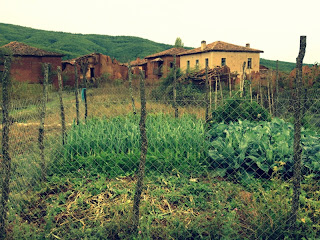-->
SEPTEMBER 20, 2012
“You want to find an abandoned village in the
mountains? You’ll never do it. I was up there with my family once and we got
so lost we thought we would never make it out.”
- Skeptical Greek guy next to me on the plane ride to Athens
Up to this point in the trip there had easily been five to
ten missed connections, wrong turns, or general navigation screw-ups each
day. Today, we were headed out to the villages my
grandparents left in the early 1900's. Until speaking
with the locals at our hotel, our directions consisted of a couple hand written
notes my mom took when speaking with one of the last living relatives from that
generation who by chance was passing through Michigan about a month before our
departure.
Not only did we find the villages today. We found them without a single wrong turn,
U-turn, or nav error. It’s like we were
guided.
I have a pile of video footage I’ll put together at some
point. It showcases the both
villages. For now, here are some
nuggets.
My grandmother’s village of Gabresh, present day Gavros, was
still operational as late as the 1950’s based on some stamped concrete we
found. Currently, it is a ghost
town. The only thing still operational
is the church, pictured in the back of this shot.
This destination being the main focus of the trip, and one
that would likely never be repeated in my or my parent’s lifetime, I really
didn’t know what to expect. Sure, it was
a big deal. A really big deal. That I knew.
I just wasn’t sure of what it would be like emotionally if we actually
found it. And there we were. We found it.
I wasn’t really prepared for the state of ruin the village
was in. After visiting various
historical sites that had stood for centuries, I thought the villages would
have survived as well. Of course, the
major cities of civilizations past had been built by entire slave colonies
using granite and marble. Gavros was
build by a few of the people who lived in it 120 (200?) years ago out of
homemade bricks, filled with stones and hay.
As usual, the best findings were those slightly off the
beaten path. I discovered a couple fruit
and nut trees.
I was later told that these were plum and apricot trees and
what plums and apricots are supposed to look and taste like in the absence of
genetic modifications and chemicals. I
couldn’t help but wondering if it was possible that these are the same trees my
grandmother spoke about. She left home
at age 12 in 1920. Is it possible that
these trees live and bare fruit for that long?
I don’t know what science says, but I’d like to believe so.

We were told by a relative that my grandmothers house was
the first house.
We never asked, “Right
or left?”
If it is the one on the right,
what is left is merely a shell.
If it was the first on the left, it is still standing. Sort of.
My grandfather’s village of Kranionas is also in an abandoned state of
collapse.
Although, some of the buildings were in a bit better shape
and being used by some folks to store hay.
Other open spaces were still being farmed.
The villages of my grandparents are only about five
kilometers apart, maybe less. This is
only odd when you consider that they did not meet until after they individually
crossed the ocean by boat, landed in Canada, and immigrated (illegally) to
Detroit. When I think about the general
discomfort or the complexity of the logistics of my trip, I can’t imagine what
they went through. A night without Wi-Fi
and I’m lost.

Both villages were located in the mountains.
Everyone in the family likes to quote my grandmother
describing her youth, “…in the mountains with the bears and snakes,” which was
at least partly validated by this warning sign a couple kilometers down the
road on the fancy new Greek highway.
I’d have to give the nod to my grandfather’s village in
terms of beauty. The views were pretty
spectacular.



















































